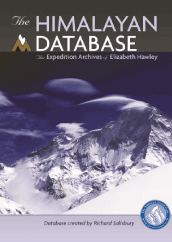Background
The Himalayan Database (HDB), was developed and maintained by Elizabeth Hawley, who remained involved up to her death in 2018. [1] [2] [3] [4] [5] It was published as a CD and an 80-page paperback up until 2017. [4] From 2017 onwards, records of expeditions, their members have been searchable online, or available as a complete downloadable database. It fills in for the absence of officially maintained records. [6] It has been published by the American Alpine Club. [7]
As well as being an important repository for climbing statistics on Himalayan mountains, the database also became known for its decisions to disregard or dispute various climbs. [8] [9] Notable cases was the decision not to record a 1990 ascent of Cho Oyu by British climber Alan Hinkes, which put a question-mark over Hinkes' claim to have summited all 14 eight-thousanders; [10] and the 1997 ascent of Lhotse by Italian climbers Fausto De Stefani and Sergio Martini [11] which forced Sergio Martini to reclimb Lhotse in 2000 to verify he had climbed all 14 eight-thousanders (De Stefani decided not to re-climb).
This page is based on this
Wikipedia article Text is available under the
CC BY-SA 4.0 license; additional terms may apply.
Images, videos and audio are available under their respective licenses.
